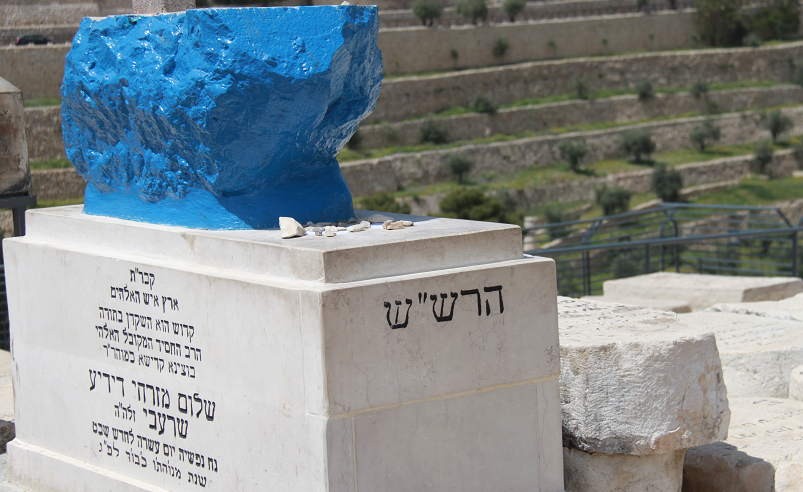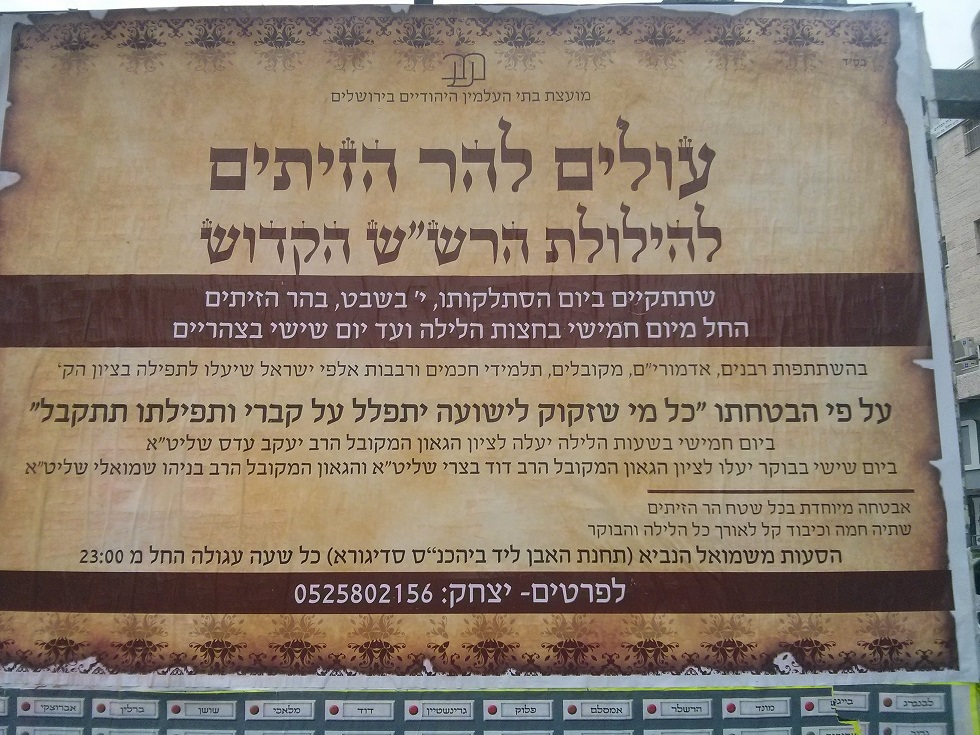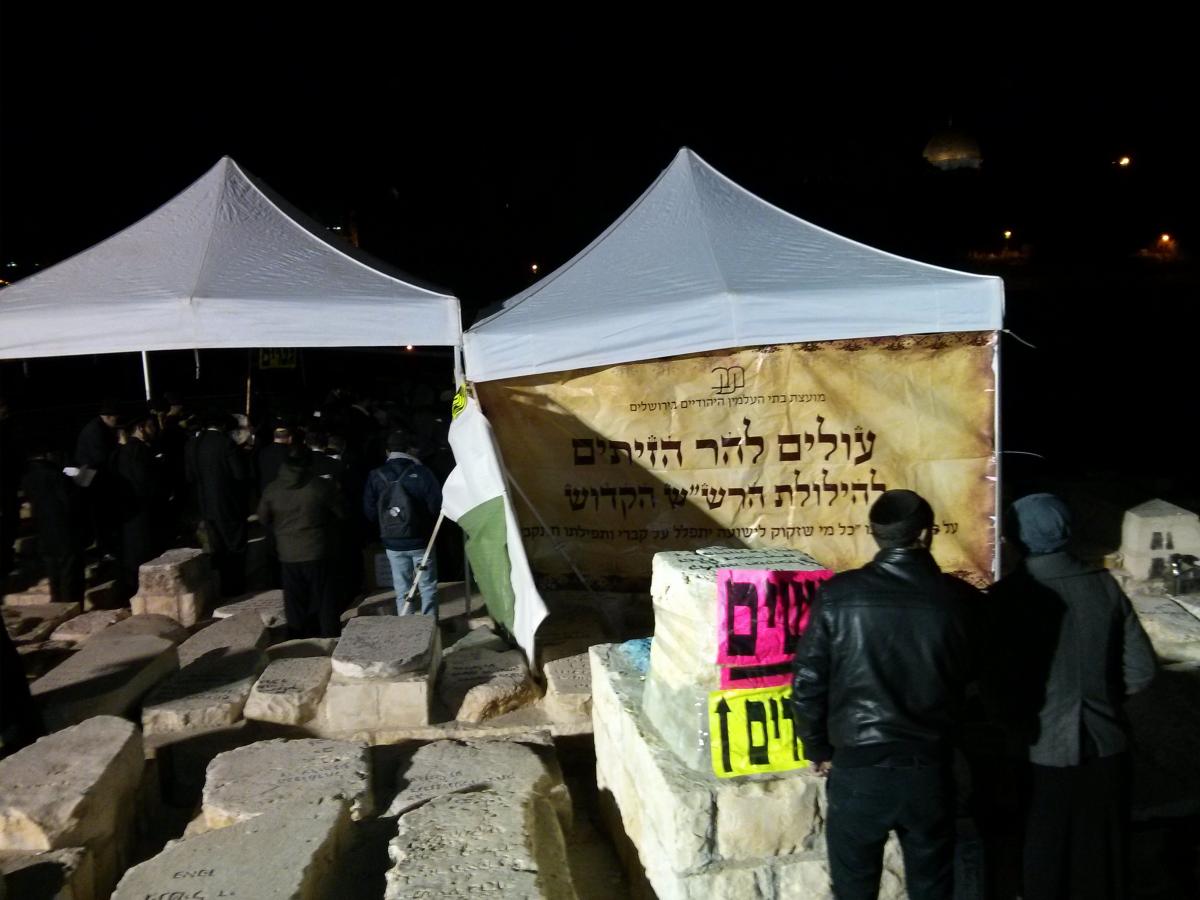


The Grave of The Rashah is located at the bottom of the Jewish Cemetery in the Mount of Olives in Jerusalem.
Rabbi Shalom Sharabi (1720-1777), better known by his acronym, the holly Rashash by his devotees, is considered one of the greatest Kabbalist of the 18thcentury.
The Rashash was born in Yemen but came to Israel at a young age. Legend tells that he worked as a cleaner at the famous “Yeshivat Bet-El”, a yeshiva known for its unique engagement with Kabbalah. As traditions would have it he initially hid his knowledge in Kabbalah and while cleaning the yeshiva at night, he would leave anonymous notes supplying answers to the questions students had during the day. One day he was discovered by the head on the Yeshiva – Rav Gedalya Chayun, who offered him to wed his daughter – Chana. The Rashash agreed and became the Head of the Yeshiva himself after his father in-law passed away.
His most famous book is a prayer book called “The Rashash Siddur” which includes kabbalistic meditations to focus on while reciting the daily prayers.
Devotees, especially members of Bet-El yeshiva, visit his grave on the anniversary of his death – The Tenth of Shvat.
Lea Taragin-Zeller
Notes on the Hilula of Rashash
Omer Hacker

Thursday night to Friday morning (22:00-2:00; 5:00-8:00), 29-30.1.14, י' בשבט התשע"ה.
"Whoever is in need of salvation shall pray on my grave and will be acceded" (Rashash quoted in the publications of the anniversary memorial day).

A regular visit at the spacious cemetery on Mount of Olives will not focus on Rashash tomb. The place is populated by a variety of very famous Jewish figures of fame and notoriety, such as former Israeli PM Begin or Rabbi  Abraham Isaac Kook. Surely, they are much more famous than the 18th century Kabbalist, Rabbi Shalom Shara’abi or better known by his acronym; Rashash. In the first hour of my most recent ethnography at the site no one visited the grave save one group of an American Orthodox Jews who had a guided tour in the cemetery of which the Tomb of Rashash was part of their itinerary. Thus, I was surprised when Motti, the manager of the information center of the cemetery (operated by Elad foundation), told me they anticipate thousands of devotees to attend the upcoming Hilula, the festivity which commemorates the Rashash birthdate.
Abraham Isaac Kook. Surely, they are much more famous than the 18th century Kabbalist, Rabbi Shalom Shara’abi or better known by his acronym; Rashash. In the first hour of my most recent ethnography at the site no one visited the grave save one group of an American Orthodox Jews who had a guided tour in the cemetery of which the Tomb of Rashash was part of their itinerary. Thus, I was surprised when Motti, the manager of the information center of the cemetery (operated by Elad foundation), told me they anticipate thousands of devotees to attend the upcoming Hilula, the festivity which commemorates the Rashash birthdate.
Few days before the date I've saw posters and flyers in neighborhoods in Jerusalem calling people to pray on the Hilula and announcing that famous Kabbalists attending during the Hilula, there will be heightened security, refreshments, and a special shuttle service will operate from some orthodox neighborhood as of Thursday (March 28, 2015) at 23:00. Another public announcement made by the Israeli Ministry of Religious Services, which is currently headed by a delegate of by the Religious-Zionism and rightwing party The Jewish Home; a party which highlights the political importance of Jewish mass events in this controversial zone of Mount of Olives.
When I came to the Hilula at 22:00, the place looked totally different from regular days therein. Several police vehicles spread along the main road that crosses the cemetery and their flashing lights colored the street; buses full with devotees stopping by; dozens of Jewish people; portable toilets; portable washbasin following the Jewish custom of washing hands after visiting a graveyard; a special station was placed by the entrance to the cemetery and delivered free Kugel (a famous Jewish Ashkenazi sweet noodles delight), cheap pastries and sweet tea were all offered to the pilgrims. Arguably judging by this typical food, and also by the two Ashkenazi Haredim workers who dispended it, I deduce that the origin of the donor and also that site of Rashash is of no the interest to Sephardic Jews.
The surrounding of the tomb itself was stark different to what I see in my regular visits and it a totally different atmosphere. At the entrance to the graveyard stood few Religious-Zionism youths with safety vests. Makeshift gazebo was constructed above the tomb and a partition has been set at the middle of it and split the devotees into men's and women's sections. The men's section was open and enlighten while the women's was closed and dark. The graves around Rashash's were turned to tools, some of them were the base of the gazebo, others a place for charity boxes and prayer books, sign of separation between men and women pasted on the grave of one of Rashash's disciples. It felt like the whole cemetery is centered by the blue rock on the top of Rashash's grave.In order to trace promoter of this production, one can find three different big signs. The first and the largest belong to the Jerusalem Cemetery Council, a branch of the governmental Ministry for Religious Services, which also published the street ads I've seen about the transportation. The second sign, smaller, set by the refreshments area, was anonymous. The third, which was located at the entrance to the cemetery, was put there by the Chevra Kadisha (general name for Jewish burial organization) of the Sephardic Jews of Jerusalem. None of them had dates on it, perhaps they are put to use each year before the Hillula.
Most of the people who visited the place during the Hilula were Haredim, specifically, Haredim Sephardim and Ashkenazi Hassidim. There were a few Religious-Zionism and a similar number of traditionalists Jews (who  aren't live fully religious life neither secular), vast majority of them from Sephardi origin. I guess the ratio between men to women was around 8:1 to men. The division of the visitors into groups is varied, some couples, different family units (father and son was common), some alone and some with friends. One social structure that caught my eye was that of a group of devotees led by their Rabbi. During the peak, from 23:30 to 1:30, there were more than one hundred men and more than fifteen women at the tomb.
aren't live fully religious life neither secular), vast majority of them from Sephardi origin. I guess the ratio between men to women was around 8:1 to men. The division of the visitors into groups is varied, some couples, different family units (father and son was common), some alone and some with friends. One social structure that caught my eye was that of a group of devotees led by their Rabbi. During the peak, from 23:30 to 1:30, there were more than one hundred men and more than fifteen women at the tomb.
People were coming to visit the tomb throughout the day. A regular pilgrimage and visitation was roughly 30 minutes. One may draw the following multistep analysis of the visit: arriving by the official subsidized transportation or by privet car or hitchhiking; lingering of few moments when leaving the bus for checking the area and then
going down to the grave of Rashash; walking through the uncomfortable pathways of the cemetery; efforts to reach the tombstone through the crowd; by the grave, praying, saying Selichot and reading Tehillim (Psalms); before leaving the area, tossing coins into the difference charity boxes and sometimes light a candle. At this stage, a large majority of the pilgrims continue to the grave of the "holy Or ha-Chaim"; ascending back to the road, some of the people washing their hands; stops at the refreshments area and having social conversations; this is the last station. From here, most of the people leave back to their business and some stops at the western wall before.
How can we decipher or understand the nature of this pilgrimage as it is unfolded during this annual memorial. To my understanding, the appendix visits in the western wall or at difference holy tombs in the Mount of Olives should be seen against the lack of rituals and elements around the grave. The devotees who came especially to the area

look for a program richer and longer than 30 minutes of quiet reading of psalms by the grave. Maybe some extensions will be developed in following years, only time will tell.
This can be also one of the conclusions of the impresarios, who were the main driving force behind the formation of this Hilula. From conversations I had with different visitors, the majority heard about the event from the advertisements of the Ministry of Religious Services on street boards and on public transportations vehicles. In addition, many of the people arrived to the place using the free buses and some of them mentioned also the importance of the announcement on reinforced police presence for enabling their visit. It should be understood against current tension between local Palestinians living in the vicinity of the cemetery and Jewish visitors therein. In other words, the succession of this event had a lot to do with the rising of kabbalah in the Jewish culture in Israel, but also to intense and determined work of impresarios who strive to evoke the Jewish activity in the place. During the seven hours during which I carried this ethnography I saw hundreds of people and the organizers I have talked to assured me it will reach thousands of pilgrims in the remaining hours.